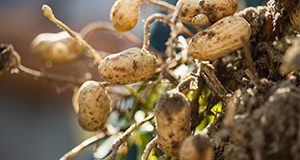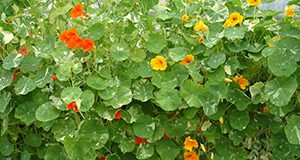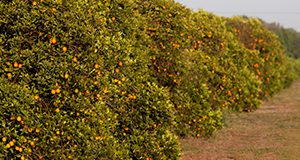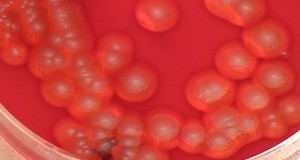This seven-page fact sheet includes a summary of various fungicide spray programs for fungal disease control of early leaf spot, late leaf spot, and white mold/stem rot of peanut in 2012-2016 on-farm trials in Hamilton County. Written by K.W. Wynn, N.S. Dufault, and R.L. Barocco and published by the Plant Pathology Department.
http://edis.ifas.ufl.edu/pp334
Author: Allison Nick
Preventing Foodborne Illness: Clostridium botulinum
Clostridium botulinum is the bacterium that causes botulism.This seven-page fact sheet describes the different types of botulism, the symptoms of botulism, the foods associated with botulism, and ways to prevent botulism. Written by Keith R. Schneider, Renée M. Goodrich Schneider, Ploy Kurdmongkoltham, and Bruna Bertoldi and published by the Food Science and Human Nutrition Department.
http://edis.ifas.ufl.edu/fs104
Raising Healthy Children: Wheat Allergies
If your child has been diagnosed with a wheat allergy, you may be wondering what you will feed him or her, because wheat is an ingredient in so many foods. Learning about ways to manage and treat your child’s allergy can help make this diagnosis less scary. This six-page publication is designed to provide you with information about wheat allergies and tips to help keep your child safe and reaction-free. Written by Pooja Tolani and Gail P.A. Kauwell and published by the Food Science and Human Nutrition Department.
http://edis.ifas.ufl.edu/fs299
Eight New Potato Variety Trials Spotlights
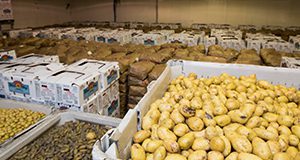
The following eight new potato variety trials spotlights explain the results of the trials and describe the different cultivars. They are published by the Horticultural Sciences Department.
-
HS1293 University of Florida Potato Variety Trials Spotlight: ‘Adirondack Blue’ by Rodrick Z. Mwatuwa, Christian T. Christensen, Pam Solano, and Lincoln Zotarelli
http://edis.ifas.ufl.edu/hs1293 -
HS1294 University of Florida Potato Variety Trials Spotlight: ‘Fabula’ by Rodrick Z. Mwatuwa, Chrsitian T. Christensen, Pam Solano, and Lincoln Zotarellia
http://edis.ifas.ufl.edu/hs1294 -
HS1295 University of Florida Potato Variety Trials Spotlight: ‘Peter Wilcox’ by Rodrick Z. Mwatuwa, Christian T. Christensen, Pam Solano, Kathleen G. Haynes, and Lincoln Zotarelli
http://edis.ifas.ufl.edu/hs1295 -
HS1296 University of Florida Potato Variety Trials Spotlight: ‘Yukon Gold’ by Rodrick Z. Mwatuwa, Christian T. Christensen, Pam Solano, and Lincoln Zotarelli
http://edis.ifas.ufl.edu/hs1296 -
HS1297 University of Florida Potato Variety Trials Spotlight: ‘LaChipper’ by Rodrick Z. Mwatuwa, Christian T. Christensen, Pam Solano, and Lincoln Zotarelli
http://edis.ifas.ufl.edu/hs1297 -
HS1298 University of Florida Potato Variety Trials Spotlight: ‘Harley Blackwell’ by Rodrick Z. Mwatuwa, Christian T. Christensen, Pam Solano, Kathleen G. Haynes, and Lincoln Zotarelli
http://edis.ifas.ufl.edu/hs1298 - HS1299 University of Florida Potato Variety Trial Spotlight: ‘Goldrush’ by Rodrick Z. Mwatuwa, Christian T. Christensen, Pam Solano, and Lincoln Zotarelli http://edis.ifas.ufl.edu/hs1299
-
HS1300 University of Florida Potato Variety Trials Spotlight: ‘French Fingerling’ by Rodrick Z. Mwatuwa, Christian T. Christensen, Pam Solano, and Lincoln Zotarelli
http://edis.ifas.ufl.edu/hs1300
Residents' Perceived Landscape Benefits Can Help Extension Promote Good Landscape Management Practices

Households can help conserve and protect water resources through irrigation and fertilizer best practices without compromising the quality of their landscape. UF/IFAS Extension, along with Extension services across the country, conducts programs to protect water quality and quantity by educating communities and individuals about research-based landscape practices. This four-page fact sheet describes the results of a survey that can help Extension promote good landscape management practices. Written by Laura A. Warner, Amanda D. Ali, and Anil Kumar Chaudhary and published by the Department of Agricultural Education and Communication.
http://edis.ifas.ufl.edu/wc282
Important Resources for the Development and Sustainability of School Garden Programs
Extension agents serve as a valuable resource in providing teachers with in-service training and technical education to increase their ability to effectively use gardening as an instructional tool. This three-page document provides an outline of important resources to help in the development and sustainability of a school garden program. Written by John M. Diaz and Erin Elsberry and published by the Department of Agricultural Education and Communication.
http://edis.ifas.ufl.edu/wc283
Seven New Spanish Translations in Food Science and Human Nutrition

The following new Spanish translations have been published in the Food Science and Human Nutrition Department:
- FS291/FSHN15-10S Enfermedad renal crónica: fósforo y su dieta by Nancy J. Gal, Lauren Headrick, Kate Bennett, and Wendy J. Dahl http://edis.ifas.ufl.edu/fs291
- FS292/FSHN16-3S Datos sobre grasas y aceites by Tiffany N. Stodtko and Wendy J. Dahl http://edis.ifas.ufl.edu/fs292
- FS293/FSHN16-9S Enfermedad renal crónica: Potasio y su dieta by Ashley R. Kendall, Nancy J. Gal, and Wendey J. Dahl http://edsi.ifas.ufl.edu/fs293
- FS294/FSHN16-1S Alimentos en puré: Guía para comidas rápidas by Wendy J. Dahl http://edis.ifas.ufl.edu/fs294
- FS295/FSHN12-18S Conteo de carbohidratos: Comidas para la Diabetes by Cassie Rowe, Jamila R. Lepore, and Wendy J. Dahl http://edis.ifas.ufl.edu/fs295
- FS296/FSHN16-4S Beneficios para la salud del aceite de olive y extractos de oliva by Wendy J. Dahl, Michael A. Tandlich, and Julie England http://edis.ifas.ufl.edu/fs296
- FS297/FSHN16-8S Una guía sobre probióticos y salud by Wendy J. Dahl http://edis.ifas.ufl.edu/fs297
Dietary Guidelines for Americans 2015–2020: A Summary
About half of all adult Americans have at least one chronic disease that could be prevented. Many of these preventable chronic diseases are related to poor eating and physical activity habits. The good news is that the risk of chronic diseases, such as heart disease, high blood pressure, and type 2 diabetes, can be reduced with the help of the 2015 Dietary Guidelines for Americans, which is described in this five-page fact sheet. Written by Kelly Johnston and Karla P. Shelnutt and published by the Food Science and Human Nutrition Department.
http://edis.ifas.ufl.edu/fs298
Preventing Foodborne Illness Associated with Clostridium perfringens
The bacterium Clostridium perfringens causes one of the most common types of foodborne gastroenteritis in the United States, often referred to as perfringens food poisoning. It is associated with consuming contaminated food that contains great numbers of vegetative cells and spores that will produce toxin inside the intestine. This six-page fact sheet describes the bacterium, outbreaks associated with it, and how to prevent illness from this bacterium. Written by Keith R. Schnedier, Renee Goodrich-Schneider, Ploy Kurdmongkoltham, and Bruna Bertoldi and published by the Food Science and Human Nutrition Department.
http://edis.ifas.ufl.edu/fs101
Powdery Mildew on Nasturtium in South Florida
Powdery mildew, which is caused by the fungus Leveillua rutae (syn. Oidiopsis haplophylli) on nasturtium (Tropaeolum majus L.), was found in southwest Florida for the first time in 2015 (Fayette et al. 2016). This two-page fact sheet describes the pathogen, its symptoms, and how to manage it. Written by Pamela D. Roberts, Katherine E. Hendricks, Francesco Di Gioia, Joubert Fayette, and Monica Ozores-Hampton and published by the Plant Pathology Department.
http://edis.ifas.ufl.edu/pp335
Tools for Evaluating Soil Health
Soil health is a term synonymous with soil quality. It refers to the chemical, biological, and physical characteristics that influence a soil’s ability to function sustainably and to satisfy the needs of humans, support plants, and cycle elements, water, and energy between earth systems. This four-page fact sheet identifies ways to evaluate soil health. Written by Jehangir H. Bhadha, Jay Capasso, Robert S. Schindelbeck, and Allan R. Bacon and published by the Department of Soil and Water Sciences.
http://edis.ifas.ufl.edu/ss657
Reframing Leadership
Effective leadership is essential in the businesses where we work, the institutions where we learn and in the communities where we live. Our own leadership is a product of how we see the world. This three-page article looks at Bolman and Deal’s book Reframing Organizations and the different frames to address organizational issues and leadership. Written by Matthew Sowcik, Hannah Carter, and Valerie McKee and published by the Department of Agricultural Education and Communication.
http://edis.ifas.ufl.edu/wc284
Citrus Fruit Blemishes and Decay Caused by Fungi and Bacteria
This new one-page citrus identification fact sheet illustrates different blemishes from fungi and bacteria that affect citrus. Written by Mark A. Ritenour, Jamie D. Burrow, Megan M. Dewdney, and John Zhang and published by the Horticultural Sciences Department.
http://edis.ifas.ufl.edu/hs1291
Managing the Health and Productivity of HLB-Affected Groves
After years of extensive research from across the world, we still do not have a cure for HLB; however, we have learned a lot about this disease, the plant’s response to the disease, and the disease vector. Based on scientific and observational information gathered in the last decade, a number of tools and strategies are currently available for growers to maintain the health and productivity of HLB-affected trees. This four-page fact sheet will shed light on these currently available horticultural inputs and practices that can be implemented immediately by growers to maintain and improve citrus tree health.Written by Tripti Vashisth and published by the Horticultural Sciences Department.
http://edis.ifas.ufl.edu/hs1288
Citrus Disorders and Physical/Chemical Injuries
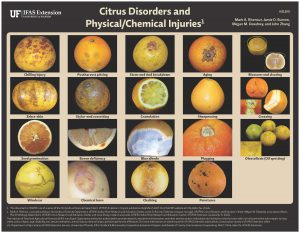
This new one-page Citrus Identification fact sheet illustrates different disorders and injuries that affect citrus. Written by Mark A. Ritenour, Jamie D. Burrow, Megan M. Dewdney, and John Zhang and published by the Horticultural Sciences Department.
http://edis.ifas.ufl.edu/hs1290
Citrus Nutrition Management Practices
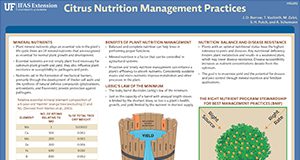
A new two-page fact sheet has been published by the Horticultural Sciences Department and the UF/IFAS Citrus Research and Education Center about citrus nutrition management practices. It was written by J.D. Burrow, T. Vashisth, M. Zekri, S.H. Futch, and A. Schumann.
http://edis.ifas.ufl.edu/hs1292
Florida Fertilizer Usage Statistics
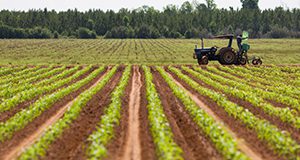
Nutrient applications are often required to meet Florida’s demand for agricultural and horticultural commodities, but often those applications occur in close proximity to water bodies. In order for scientists, policy makers, and citizens to make decisions regarding nutrient issues in Florida, it is important to first understand which markets contribute to Florida’s fertilizer consumption. This three-page fact sheet explains Florida’s fertilizer usage statistics. Written by T.W.Shaddox and published by the Environmental Horticulture Department.
http://edis.ifas.ufl.edu/ep541
Worker Protection Standard: Respirators
On November 2, 2015, the EPA revised the WPS, making significant changes to the rule’s requirements. Most of the revised provisions became effective January 2, 2017; there are four provisions that are delayed until January 2, 2018. This four-page document will address respirator use under the revised WPS. Written by Frederick M. Fishel and published by the Agronomy Department and the Pesticide Information Office.
http://edis.ifas.ufl.edu/pi272
Education and Facilitation Methods for Extension
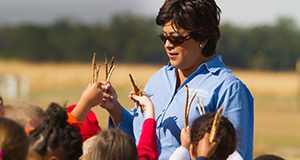
Extension faculty, staff, and volunteers serve a wide variety of stakeholders who learn in myriad ways. Education research provides insight into the effectiveness of such tools, and Extension further encourages flexibility and innovation in methods when facilitating programming. This six-page fact sheet explains how to incorporate new education methods into Extension programming. Written by Kathryn A. Stofer and published by the Department of Agricultural Education and Communication.
http://edis.ifas.ufl.edu/wc281
Preventing Foodborne Illness: Bacillus cereus
Ingesting foods contaminated with Bacillus cereus bacteria can lead to nausea, vomiting, abdominal cramps, and diarrhea. Though B. cereus is commonly found in many types of fresh and processed foods, proper cooking, handling, and storage can minimize the risk of contamination. This 5-page fact sheet explains how B. cereus is transmitted, what foods it is commonly associated with, the methods used to prevent contamination, and good practices for receiving, handling, processing, and storing food. Written by Keith R. Schneider, Renée Goodrich Schneider, Rachael Silverberg, Ploy Kurdmongkoltham, and Bruna Bertoldi, and published by the Department of Food Science and Human Nutrition.
http://edis.ifas.ufl.edu/fs269
